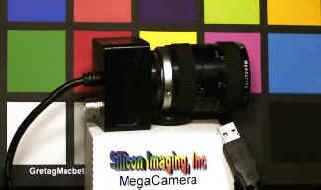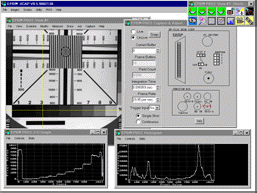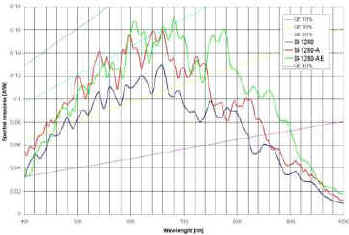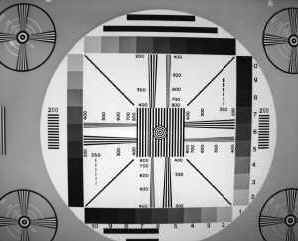SI-1280F- M & RGB MegaCamera™
1.3 Megapixel, 12-Bit, 60MHz
Ultra-Fast Full-Frame Shutter Digital Camera
Silicon Imaging Inc.
Silicon
Imaging is proud to continue its innovation in ultra-high
speed machine vision camera.
Driven by the growing demand for consumer Digital Still Cameras,
CMOS sensors are continuing to break technical barriers and surpass the
performance characteristics of CCD’s in many photonic, imaging and
consumer applications. By
utilizing a single highly integrated CMOS device, which incorporates
Megapixel sensing areas, timing generation, signal processing and high
bandwidth outputs, Silicon Imaging has developed a very compact,
low-power, ultra high speed Megapixel digital camera system.
1280
x 1024 Megapixel Imaging - Ultra Speed
The
SI-1280F is the worlds first 1.3 Million pixel Full-Frame Shutter,
all-digital CMOS camera capable of running at video rates of 40
frames/second at its full 1280 x 1024 resolution and over 500 frames/per
second at 320 x 240 resolution. The
entire package is only 45 x 52 x 50mm and is small enough to placed on a robot for semiconductor
machine vision inspection, embedded into a portable medical
instrumentation for cell biology or placed in an aerial drones for remote
surveillance.
12-Bit
Pixel Clock Sampling – Sub-Pixel Accuracy
The
MegaCameraä uses 12-Bit digitizers to
sample the pixel data at up to 60MHz to achieve 40 Frames/sec data
throughput at its full Megapixel resolution. Converting the pixel data
directly to digital at the sensor head eliminates pixel-sampling jitter
and enables accurate sub-pixel metrology, image analysis and improved live
video reconstruction.
Full-Frame
Triggered Shutter – Stop the Motion
Most
common CMOS sensors only have a “Rolling
Shutter” to control the exposure time for each line in the image.
This method can produce unwanted motion tilts or jagged edges, as
each row ends integration after the previous one above it.
The SI-1280F provides a Full-Frame triggered shutter, which
completely stops any motion artifacts by exposing all pixels
simultaneously and holding the exposed value until it is progressively
readout.
Dual
Slope Exposure - “Super-Dynamic Range”
The
SI-1280F can be used in a dual slope bi-linear mode, extending the useful
dynamic range in scenes where detail in bright areas are to be preserved
at the same time as maintaining details in darker regions. In normal linear response, a camera requires a
short exposure to keep the bright areas from saturation.
However, the darker regions of the image would not have enough time
to integrate charge. If the exposure is set longer the detail in the
dark areas will become visible by the brighter areas will become
saturated. The dual-slope operation
combines the transfer of nominal integration time (steep slope, high
sensitivity) with the transfer curve obtained from a short electronic
shutter (shorter exposure time, lower sensitivity), into a single exposing
operation.
2400
Frames per Second - Windowing & Subsampling
Ideal
for object tracking and high-speed Motion analysis, the SI-1280 is capable
of generating imagery at over 2400 frames per second by reducing the size
of the readout image (ex. 100x100).
This windowed Region-of–Interest (ROI) can be moved dynamically,
creating an entirely electronic pan/tilt/zoom function within the camera
field-of-view.
USB
2.0 and CameraLinkä
Digital Interfaces
The
SI-1280F is available with either USB 2.0 or CameraLinkä
interfaces. CameraLinkä
provides the utmost performance.
An
industry standard forum has adopted CameraLinkä,
for
low cost connectivity and cabling at very high speeds. The SI-1280F-CL can output 1280 x 1024 12 bit data at 40
frames per second (865 Mbits/second) continuously to a frame grabber.
For applications requiring more modest data rates, the SI-1280F-U
USB 2.0 cameras achieve simple connectivity at low cost.
1280 x 1024 8 bit data can be output at 20 frames per second.
A table of available frames rates for each interface is shown
below.
FEATURES
·
1280 x 1024 Resolution (1.3 Million Pixels)
·
Full Frame Triggered Shutter, Progressive scan
·
2/3” Imaging Format , 6.7um Square Pixel
·
Windowing and Subsampling
·
12 Bits per Pixel, 55MHz Sampling
·
High Speed Readout (30
~ 3000FPS)
·
Region-of-Interest (ROI) windowing
·
Progressive Rolling Shutter Mode
·
1usec~4sec Precision High Speed Shutter
·
Long Integration (up to n-Frame Times)
·
Programmable Gain, Offset, Clock, Shutter &
ROI
·
External Clock Synchronization (FrameLock)
·
Monochrome & Color Bayer RGB Models
·
5VDC Low Power, Small Package
·
C-Mount Housing or PCB versions
· CameraLinkä or USB 2.0 Digital Interface
SI-1280F
MegaCamera™
Specifications
Sensor:
|
Active Pixels |
1280 (H) x 1024 (V) |
|
Optical Imaging Format |
2/3” (8.576mm X
6.861mm) |
|
Pixel Size (pitch) |
6.7um x 6.7um |
|
Pixel Type |
CMOS |
|
Aspect Ratio |
1 : 1 |
|
Spectral Response |
400 ~ 1000 nm |
|
FPN (on chip corrected) |
<0.5% |
|
PRNU |
10%p/p; 1.1%RMS |
|
Conversion Gain |
12
mV/electron |
|
Sensitivity |
1.85V/Lux.sec (visible) or
336
V.m2/W.s |
|
Fill Factor |
~55% |
|
Read Noise |
80~90 e- (sync
shutter); 70~80 e- (rolling) |
|
Dark Current
|
2100 pA/cm2 at RT or 5900 e-/s |
|
Saturation Charge |
120,000 e- |
|
Windowing (ROI) |
Programmable row/column |
|
Sub-sampling |
1:2 for color and monochrome |
|
Noise Reduction |
Correlated Double Sampling (CDS) |
|
Readout Method |
Progressive Scan |
|
Readout Types |
Destructive |
|
Shutter |
Full Frame Shutter or Rolling Shutter |
|
Shutter Speed / Integration |
Variable, 1 to 1280 Line times |
|
Minimum Blanking |
150 Clocks/line |
A/D Conversion & Sampling Clock
Synthesizer
|
A/D Conversion |
30Mhz (Nominal), 60MHz (max) |
|
Vertical Resolution |
12 Bit |
|
Pixel Clock Frequency |
20 ~ 60Mhz Programmable |
|
Adjustment Method |
Serial command Protocol |
|
A/D SNR |
67.5dB |
|
Output Noise |
0.2 LSB rms |
Digital Video Output
|
Readout
Rate |
60
MHz Maximum, PCI 8 bit @ 60MHz, PCI
12 bit @ 50MHz; PCI-X @ 60Mhz USB
@ 45MHz |
||
|
Readout
Format |
CL-12
Bit (Ports A, B) |
||
|
Frame
Rate @ Max Clock
1280 x 1024 1280 x 720 768 x 768 640 x 512 512 x 512 360 x 300 320 x 240 256 x 256 64 x 64 |
USB 8 bit
24 36 45 75 85 150 180 190 375 |
PCI –CL(12)
34 48 70 123 147 326 443 481 3650 |
PCI-X – CL(12) And PCI –CL(8) 41 58 85 148 177 392 532 577 4380 |
|
Line
Readout Rate |
23.9 usec per line @ 55MHz |
||
|
Signal-to-Noise |
>
60dB (fc=20MHz, Gains=1.0) |
||
|
Connector |
MDR 26-pin (3M 10226-6212VC)
(-CL) USB
2.0 Integrated cable (-U) |
||
CameraLink
Frame Grabber Control:
|
Serial Communication |
RS-232
Protocol 9600bps |
|
Signaling |
TX
& RX (LVDS) |
|
Asynchronous Triggers |
LVDS
– CC1, 2, 3, 4 (-CL) TTL
Trigger-In & Strobe-Out (-U) |
|
High Speed Shutter |
1usec
~ 4sec, in 1usec increments |
|
Trigger-to-Exposure |
128
clocks (3.2usec @40MHz) |
|
Long Integration |
n-Frame
Times |
|
Region-of–Interest |
Programmable
Horiz & Vertical |
|
Gain & Offset |
7
Settings (1.0x, 1.33x, 2.0x, 4x) |
|
Programmable Modes |
Full-Frame,
Window, Subsampling Long
Integration & Single-Shot |
|
Setting Timing |
Next
top of Frame |
|
Ext Clock Sync |
Clock in or Clock Out (-X
Option) |
Power
|
Input Voltage |
+5 VDC +/- 10% |
|
Power |
2.5 Watts |
|
Power/Trigger Connection |
Tajimi RO3-PB3M 3Pin (-CL) Tajimi RO3-PB5M 5Pin (-X) |
Mechanical
|
Lens Mount |
C-Mount, 7mm Back focus Adj. |
|
Enclosure Size |
45mm W x 52mm H x 50mm L |
|
Weight |
12 oz. |
|
Camera Mount |
¼” x 20standard tripod mount |
|
Cable Connector |
Cameralink MDR-26 (-CL) High-Speed
3-meter USB Cable with Type-A Connector (-U) |
Spectral Response Curve
click image to view larger version
SI-1280F CameraLink Frame Rates
The SI-1280F has a Digital Clock Synthesizer capable of generating a range of frequencies from 20MHz to 60MHz. The pixel data output rate is the same as the sampling clock rate. A range of preset frequencies are listed below. There are 150 clocks overhead per row for readout
|
MHz |
|
|||||||
|
Clock
Rate |
1280x1024 |
1280
x 700 |
800
x 600 |
640x480 |
320x200 |
240x180 |
200
x 150 |
128x128 |
|
20
MHz |
14 |
20 |
35 |
53 |
177 |
285 |
381 |
562 |
|
25
MHz |
17 |
25 |
44 |
66 |
222 |
356 |
476 |
703 |
|
30
MHz |
20 |
30 |
53 |
79 |
266 |
427 |
571 |
843 |
|
35
MHz |
24 |
35 |
61 |
92 |
310 |
499 |
667 |
984 |
|
40
MHz |
27 |
40 |
70 |
105 |
355 |
570 |
762 |
1124 |
|
45
MHz |
31 |
45 |
79 |
119 |
399 |
641 |
857 |
1265 |
|
50
MHz |
34 |
50 |
88 |
132 |
443 |
712 |
952 |
1405 |
|
55
MHz |
38 |
55 |
96 |
145 |
488 |
783 |
1048 |
1546 |
|
60
MHz |
41 |
60 |
105 |
158 |
532 |
855 |
1143 |
1686 |
Frame Rate
Calculation
To calculate the frame rate for any clock rate the equation is:
(
clock rate(Hz)
) =
# Frames Per Second (fps)
( # of columns + 150) *
( # of rows)
Example:
What is the frame rate, at 60MHz clock rate for an image size of 800 x
600?
60 x 106
=
105 Frames Per Second (fps)
(
800 + 150) * ( 600
)
** FRAME RATES are based on ROLLING SHUTTER operation. Full-Frame Shutter requires the additional time for exposure for each frame. Subsampling frame rates are based on the resulting size of the subsampled image or window.
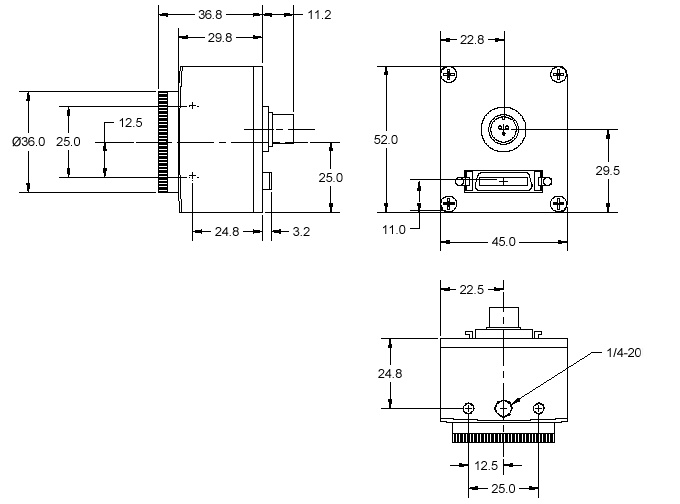
Test Image - Click to view full size


